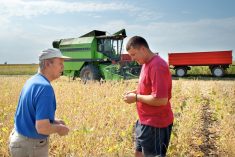Naloxone is the antidote for opioid overdoses and it works really well, proving successful in 75 to 100 per cent of cases. At one time it was scheduled by Health Canada, so that it could only be sold by prescription, but today a prescription is not needed. Anyone can purchase naloxone from their pharmacy, and in some cases their insurance plan will cover the cost.
By 2018, over 590,000 naloxone kits had been distributed in Canada and over 61,000 used. The numbers have most certainly increased in the interim.
Naloxone is a selective opioid reversal agent with over 40 years of use. It is an opioid antagonist with a high affinity for mu-receptors. This means it displaces opioids from specific receptors in the body and reverses the adverse effects of opioids, specifically respiratory depression.
Read Also

Employment Agreements Can Help Protect Your Farm
Entering into employment agreements with each of your farm employees should be at the top of every farm’s “to do” list, but caution must be exercised.
Without respiratory depression, an opioid overdose victim can breathe again and is less likely to die.
However, it is important to know that naloxone only reduces opioid effects. If the overdose is caused by any other substance, naloxone will not have any effect. It also has no psychoactive effects or potential for abuse; there is no effect if an individual is not using an opioid.
Examples of opioids include codeine, morphine, hydromorphone, oxycodone, fentanyl, methadone and diamorphine (heroin).
Naloxone is safe to use with both children and pregnant women. The reported adverse effects are related to opioid withdrawal, not the naloxone itself. Symptoms of opioid withdrawal are numerous and can include body aches, diarrhea, rapid heart beat, sweating, restlessness or irritability, shivering, abdominal cramps, weakness and increased blood pressure. However, it is always recommended that when administering naloxone a telephone call to the local emergency department and ambulance is needed. As a result, the overdose victim may be in the emergency department by the time withdrawal symptoms are seen.
Naloxone is available as an intramuscular injection and as a nasal spray. Both are easy to use. The injection can be given through clothing, even blue jeans with the thigh being the recommended location for injection. The injection should be perpendicular to the skin, like throwing a dart. The nasal spray is used in one nostril only, unlike hay fever nasal sprays which require application to both nostrils.
Naloxone kits contain either two doses of 0.4 mg of the injection or two doses of 4 mg of the nasal spray, with full instructions. The reason for the two doses is that a second one may be needed if a long acting opioid is involved in the overdose. Phoning 911 for an opioid overdose is a great idea because the operator that answers can provide instructions for naloxone use that will certainly help with the naloxone administration.
If an opioid overdose is suspected, calling 911 and administering naloxone are the first steps, but placing the individual in what is known as the recovery position, that is lying on their side with their mouth oriented downward, will help keep airways open. Rescue breathing or cardiopulmonary resuscitation (CPR) will also help. Overdose victims should not be slapped or shaken in order to “wake” them. Nor should you put them in a cold bath or shower, force them to vomit or inject them with anything else than naloxone.
Keeping naloxone handy is ideal, even if drug overdoses and misuses are thought not to occur. Opioids are widely used therapeutically in many pain conditions ranging from arthritis to cancer, and in the event of an accidental overdose, naloxone is the recommended treatment. Remember, for a friend, relative or neighbour, a naloxone kit may mean the difference between life and death.















